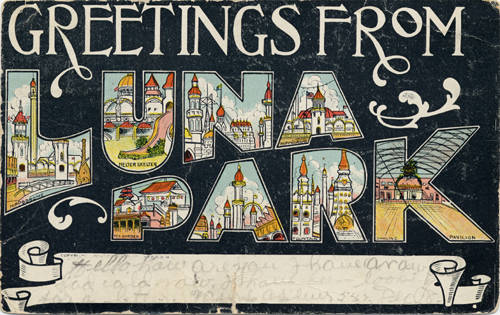
Postcard from the Postcards of Cleveland Collection, part of the Cleveland Memory Project. Credit: Michael Schwartz Library, Cleveland State University.
by Jessica Chapel
When Bill Barrow was a child growing up in Cleveland, an electric sign on the city’s West Side lodged itself in his memory. A tipped bottle of milk poured light into a glass, advertising Dairymen’s Milk, a local company. “I keep asking the world for a photo or a home movie,” Barrow told the Cleveland Plain Dealer in 2012.
He isn’t asking the world for a photo of that milk bottle sign out of nostalgia. Barrow, the Head of Special Collections in the Michael Schwartz Library at Cleveland State University, oversees the Cleveland Memory Project, a digital repository of images, oral histories, documents, and other materials chronicling the history of Cleveland. The centerpiece of the Cleveland Memory Project is the 500,000 photographs in the Cleveland Press Collection, a trove that spans decades of city life.
Launched in 2002 by the Schwartz Library in partnership with community organizations throughout Northeast Ohio, the Cleveland Memory Project has been a collaborative effort from the start, said Barrow, and outreach and advocacy work has been key to building the repository both within the library and the community.
“Not much would get accomplished if I tried to run Cleveland Memory entirely out of Special Collections,” said Barrow, explaining that he’s as motivated by idealism as he is by pragmatism. “I have an old Sixties notion of community organizing and participatory democracy fueling this all-together-now approach.”
Barrow, who holds a master’s degree in history from CSU and a master’s in library science from Kent State University, began working with the Cleveland Press Collection as a graduate student in 1993; in 1994, he was hired to process the Cleveland Union Terminal Collection at Schwartz. Both collections became part of the library’s Special Collections department when it was created in 1999, the same year Barrow was brought on as Special Collections Librarian.
The Cleveland Memory Project grew out of earlier efforts to digitize and make local history collections accessible, and a long list of teams across the Schwartz Library and CSU — including Digital Production, Discovery Services, Multimedia Services, and the Law College — was engaged to make it real.
Keeping that early momentum going remains a priority. “The Cleveland Memory Team has meetings monthly at least 11 times a year and is very well attended,” said Barrow. “We use it to keep everyone abreast of relevant developments and to discuss new project proposals.”
It’s that engagement that gives Barrow reason to believe the work of the Cleveland Memory Project will continue well into the future. “The challenge is always money. I’d gone to library school at age 48, so recognizing that my economic life as a librarian wouldn’t be 50 years, targeted my ambition on trying to get as much of the print-based local history resources into the digital realm as I could,” said Barrow.
“There’s still tons to be done. More money, more staff, more everything, would push that job closer to completion. But with the Cleveland Memory Team functioning so well, I think they’ll carry on, state budget permitting.”
Barrow cautioned that buy-in can’t be taken for granted. “Silos are always a problem, whether because of territoriality or lack of conviction that [an institution’s] mission calls for working with others.”
Collaborating with the audience also matters. When work on the Cleveland Memory Project began, “we started with those [topics] we knew the patrons most often requested when they came into Special Collections. We have a feedback loop where people can ask questions, correct mistakes, or volunteer collections to donate,” said Barrow.
“We have allowed other libraries, historical societies, government agencies and even individuals to mount material in Cleveland Memory, which helps us focus outward more. The idea is not to have a show-window where the CSU staff decides what the people want to see, but rather a community stage where we invite colleagues at other institutions to put material up from their holdings.”
Barrow plans to keep finding ways to bring the larger community into the archives. He gives talks around the region, speaking to civic groups about the Cleveland Memory Project and Special Collections. He’s made use of a blog and a newsletter — as well as Facebook and Twitter — to connect with the Cleveland Memory Project’s audience.
And to connect with donors, who have added their items and memories to the repository. If the world hasn’t yet come through with a photo or video of that old electric sign for the Cleveland Memory Project, longtime Cleveland denizens did with reminiscences when Barrow put out the call on his blog. Dairymen’s Milk still haunts more than a few people’s dreams.
Looking ahead, Barrow’s thinking about how to make collections more available to the public.
“I’m coming around to an access mode for Special Collections, rather than a preservation one,” said Barrow. “While still acknowledging the importance of preserving primary sources, I’m opting for a model whereby Special Collections is the repository of material destined for digitization and access. To me, preservation has always been only a long-term access strategy and now, with digital technologies, we can provide superior access without particularly compromising the preservation factor.”
